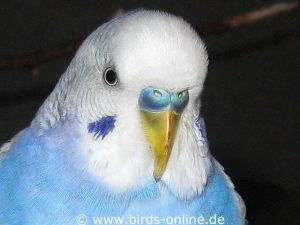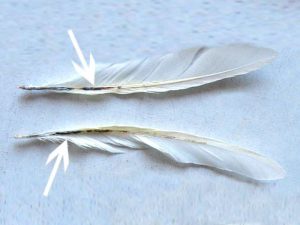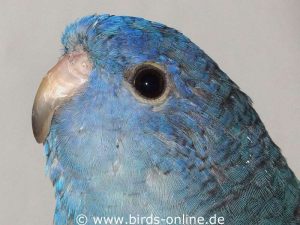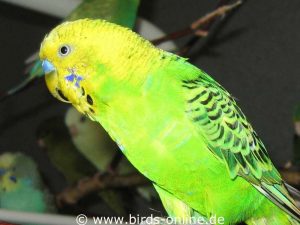- >>
- Birds Online – English
- >>
- Health and diseases
- >>
- Infectious diseases and diseases...
- >>
- Liver disorders
Liver disorders and liver diseases
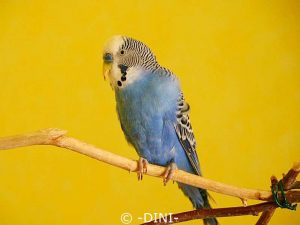
Liver disease is relatively common in some pet birds. Budgies are particularly often affected. One important reason for this is that some bird species are particularly prone to fatty liver disease. Other typical triggers for liver disease that occur comparatively often are infections and tumours. It is not always easy to recognize an incipient liver disease as such right away. This is because diseases of this vital organ initially cause rather unspecific symptoms in many cases. In addition, some of the symptoms can also occur in other diseases. For this reason, liver diseases are often only diagnosed when they are already quite advanced. It is therefore important for bird owners to be aware of possible warning signs and to be able to have appropriate examinations carried out by an avian vet as early as possible. This chapter is intended to help you to identify liver disorders and to initiate the right treatment measures in the event of such diseases.
Symptoms
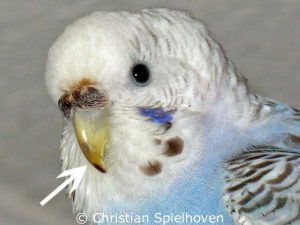
A typical symptom of liver dysfunction in budgies is excessively strong beak growth, which is often accompanied by deformation of the beak. In some cases, discoloration may occur as well. Many budgies, for example, show dark red discoloration on the upper beak. These dark spots are haemorrhages inside the keratin part of the beak. In some birds, the claws also turn extremely dark over time, especially at the tips. In addition, many birds suffering from liver disorders have a blunt and shaggy plumage. But overall it is usually intact, there are no bald patches like you would expect in the case of PBFD, for example. Likewise, several feathers may grow back too long or show an unusual coloration due to a liver disorder.
Please note: If there is a beak deformation in combination with crooked, shaggy feathers or even bald patches, the affected bird possibly suffers from a viral disease such as PBFD. A deformed beak covered with crusts, on the other hand, is often a symptom of scaly mites. These are just two examples of health issues that can be confused with the symptoms of liver disorders. For a layman, it is therefore difficult to reliably identify the cause of beak deformation. A bird whose beak has an excessively strong or altered growth should be examined by an experienced avian vet.
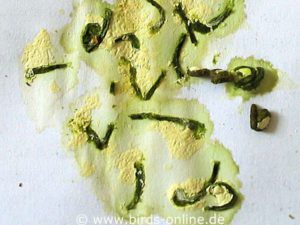
Many liver disorders can be recognized by the fact that the affected birds excrete feces with altered shape, consistency, and colour. The feces of budgies suffering from a liver disorder are often greenish and show a yellow urine section. In the photo near this paragraph, you can see that the urine can be yellow instead of white. The bird who excreted these droppings was suffering from severe liver disease. However, the droppings are not always conspicuously and characteristically discoloured. There are birds whose droppings – at least in the early stages of the disease – look perfectly normal.
Other symptoms that may occur as a result of severe liver disorders include drowsiness, paralysis, sudden failing eyesight (ametropia), tremors, and general disorientation. All these symptoms may indicate that the liver is no longer working properly, which is why the organism is not sufficiently detoxified. Thus, the body is flooded with various toxic substances that damage the nervous system. The symptoms often appear abruptly, because over time the amount of harmful substances in the bird’s body slowly increases and the organism can no longer cope with these toxins at a certain point. However, other conditions can cause similar symptoms. This is why clarification of the situation by an avian veterinarian is essential.
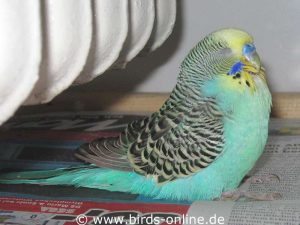
The following video shows a budgie suffering from a neurological deficit due to an inflammation of the liver (hepatitis). As a result, he was trembling and disorientated, but he most likely didn’t suffer from pain. The feathers on his face were sticky from the medication. Since he was a tame bird, taking the picture and making the video did not frighten him. Also being with his friends calmed him down more than the stay in the hospital cage would have. Regrettably, his condition did not improve despite intensive veterinary care and he had to be euthanized three days after the video shown below has been taken.
Diagnosis
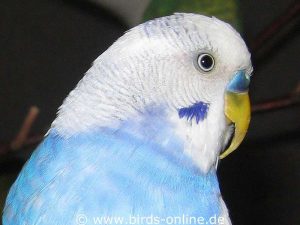
To reliably diagnose liver disorders, the avian vet should take an X-ray or carry out a blood analysis. Using the latter, the liver enzymes can be checked. Although some people claim that blood cannot be obtained from birds since these animals are so small, it is possible. However, the overall condition of a feathered patient may be very poor in the individual case due to severe illness. So immediate blood testing may not be an option without risking the bird’s life. An X-ray examination can also be distressing. If a bird is extremely weak and unwell, there is still the option of palpation. A diseased liver is usually severely swollen. Such swelling can often be sensed by an experienced avian vet. But the exact degree of the liver disorder usually can’t be assessed in this way. Further measures such as X-rays and blood tests are necessary as soon as the bird’s general health condition will allow.
Treatment
Liver dysfunctions as a result of fatty liver disease can often be alleviated with the help of a special diet including nutrient-rich food supplements. Despite this, treatment is not necessarily possible in all cases. Overweight birds must gently and slowly lose weight. Besides this, a permanent change in diet is usually required. You will find more information on this topic in an article that will be published here shortly. In any case, the diet and treatment plan should be set up by an avian vet.
Other liver diseases such as inflammation can usually also be treated with certain food supplements and liver protection preparations. Quite often, preparations containing milk thistle are used. In some cases, it may be useful to mix the bird’s food with milk thistle powder. But this measure should be discussed with the avian vet. An extra portion of amino acids, vitamins, and minerals may also be useful. Liver dysfunction as a result of a tumor is treated similarly. Surgeries to remove the tumours are hardly ever possible.
It varies from case to case how long the treatment should be carried out. It should be determined individually by your vet – the same applies to the medicines and food supplements used. Some birds are largely symptom-free after four weeks, others have to be supported by liver protection therapy throughout their lives. Treatment of a bird supposedly suffering from a liver disorder on its own is not advisable. You should principally consult a vet.

